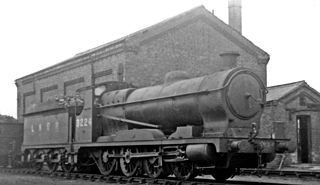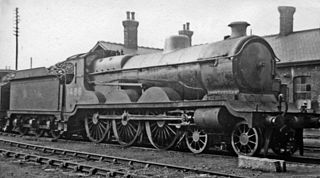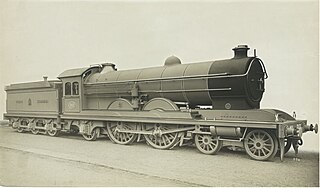John George Robinson CBE, was an English railway engineer, and was chief mechanical engineer of the Great Central Railway from 1900 to 1922.

The London and North Eastern Railway LNER Gresley Classes A1 and A3 locomotives represented two distinct stages in the history of the British 4-6-2 "Pacific" steam locomotives designed by Nigel Gresley. They were designed for main line passenger services and later express passenger services, initially on the Great Northern Railway (GNR), a constituent company of the London and North Eastern Railway after the amalgamation of 1923, for which they became a standard design. The change in class designation to A3 reflected the fitting to the same chassis of a higher pressure boiler with a greater superheating surface and a small reduction in cylinder diameter, leading to an increase in locomotive weight. Eventually all of the A1 locomotives were rebuilt, most to A3 specifications, but no. 4470 was completely rebuilt as Class A1/1.
Edward Thompson was an English railway engineer, and was Chief Mechanical Engineer of the London and North Eastern Railway between 1941 and 1946. Edward Thompson was born at Marlborough, Wiltshire on 25 June 1881. He was the son of Francis Thompson, assistant master at Marlborough College. He was educated at Marlborough before taking the Mechanical Science Tripos at Pembroke College, Cambridge, earning a third class degree. Thompson entered the railway scene after education, contrasting that of his predecessor Nigel Gresley, who had also attended Marlborough after gaining practical experience as a pupil at Horwich Works.
The London and North Eastern Railway (LNER) Thompson Class Q1 was a class of 0-8-0T steam locomotives. They were rebuilds of the GCR Class 8A 0-8-0s. Thirteen were rebuilt between 1942 and 1945 at Gorton Works. All passed to British Railways in 1948, numbered 69925–69937.
Alexander Henderson, 1st Baron Faringdon, known as Sir Alexander Henderson, 1st Baronet, from 1902 to 1916, was a British financier and Liberal Unionist Member of Parliament.

The GCR Class 1 was a class of steam locomotives designed by John G. Robinson for the Great Central Railway, and introduced to service between December 1912 and 1913. In the 1923 grouping, they all passed to the London and North Eastern Railway which placed them in class B2. Their classification was changed to B19 in 1945, and all had been retired by the end of 1947.

The Great Central Railway (GCR) Class 8A was a class of 0-8-0 steam locomotive built between 1902 and 1911 for handling heavy coal trains over the Pennines. They all passed to the LNER in 1923, who redesignated them Class Q4. They were withdrawn from service between 1934 and 1951.

The GCR Class 1B was a class of 2-6-4T (tank) locomotives on the Great Central Railway. They were notable as the first locomotives of the 2-6-4T wheel arrangement to be used by a British standard-gauge railway; there had been two narrow-gauge examples on the Leek & Manifold Valley Light Railway since 1904.
Although overshadowed by the later and more famous steam locomotives that John G. Robinson would go on to design, the Great Central Railway Class 11B 4-4-0 Express Passenger engines were a successful class which totalled 40. Built from 1901 to 1903, in later rebuilt form as 11D, some 11Bs would last in service until 1950. Railwaymen continued to refer to the class as "11B" even after all were rebuilt to 11D. Being contemporary with and to some extent the 4-4-0 version of Robinson's much more numerous 0-6-0 goods class 9J, which were known as "Pom-Poms", the 11Bs acquired the nickname "Pom-Pom Bogies". The London & North Eastern Railway classified the 11Bs, along with their 11C and 11D rebuilds, as Class D9.
The LD&ECR Class D was a class of nine 0-6-4T steam locomotives supplied to the Lancashire, Derbyshire and East Coast Railway in 1904 and 1906 by Kitson & Co. of Leeds. They later became the property of the Great Central Railway and finally the London and North Eastern Railway, upon which they were known as Class M1.
GCR Classes 8D and 8E were two pairs of three-cylinder compound steam locomotives of the 4-4-2 wheel arrangement built in 1905 and 1906 for the Great Central Railway.

The GCR Class 11E was a type of 4-4-0 steam locomotive used by the Great Central Railway for express passenger services. Ten were built in the railway's own workshops at Gorton, Manchester during 1913; they remained in service until the mid-1950s.

The NBR 224 and 420 Classes consisted of six steam locomotives of the 4-4-0 wheel arrangement built by the North British Railway (NBR) in 1871 and 1873. No. 224 had three claims to fame: it was the first inside-cylinder 4-4-0 engine to run in Great Britain; it was the locomotive involved in the Tay Bridge disaster; and after rebuilding in 1885, it was the only compound-expansion locomotive on the NBR, and one of just three tandem compounds in Britain.

The GCR Class 9Q, classified B7 by the LNER, was a class of 4-6-0 mixed traffic locomotives designed by John G. Robinson for fast goods, relief passenger and excursion services on the Great Central Railway. They were a smaller wheeled version of Robinson's earlier Class 9P "Lord Faringdon" express passenger class.

The GCR Class 8C was a class of a pair of 4-6-0 locomotives built for the Great Central Railway in 1903–1904 by Beyer, Peacock and Company. They passed to the London and North Eastern Railway at the 1923 grouping and received the classification B1 They were reclassified B18 in 1943 and both were retired in 1947.
GCR Class 8G was a class of 10 two-cylinder steam locomotives of the 4-6-0 wheel arrangement built in 1906 for the Great Central Railway.
The NBR 141 Class consisted of two steam 2-4-0 locomotives built by the North British Railway (NBR) in 1869. They were the direct antecedents of the NBR 224 Class 4-4-0.

The GCR Class 8F was a class of ten 4-6-0 locomotives built for the Great Central Railway in 1906 by Beyer, Peacock and Company to the design of John G. Robinson for working fast goods and fish trains. They passed to the London and North Eastern Railway at the 1923 grouping and received the classification 'B4'.
The Great Central Railway Class 8N - London North Eastern Railway Class B6 - was a class of three 4-6-0 steam locomotives, designed by John G. Robinson in 1918. They were a mixed traffic class. All three examples were withdrawn in November and December 1947.

The NER Class Z was an Atlantic class of locomotives designed by Vincent Raven. It was introduced in 1911.










